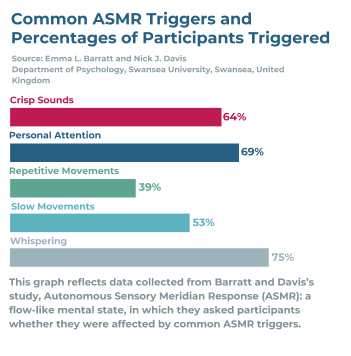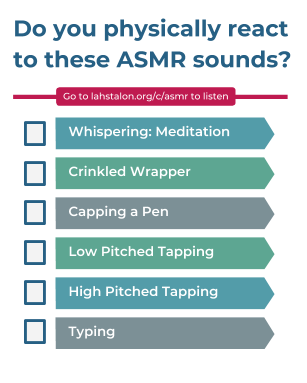ASMR: Do you tingle?
February 8, 2019
Sophomore May Jiang was in fifth grade when she began to recognize the “relaxed and comfortable” feeling she had when a friend quietly explained concepts to her. Years later, she stumbled upon a YouTube video featuring whispering that replicated the reaction.
“People say they get tingles, but my brain [mostly became] very relaxed,” May said. “I was almost in a daze, and I became very calm and very focused.”
The video was part of a growing YouTube genre—Autonomous Sensory Meridian Response, more commonly known as ASMR. The term, coined in 2010, refers to the physical response that some people have to specific sounds.
“ASMR is a tingling, relaxing sensation on or near the scalp that some people feel in response to certain stimuli, like soft voices and tapping,” National University of Singapore Assistant Professor Rebecca Starr said. “ASMR is similar to the sensation of being tickled. You sometimes feel it, and you sometimes don’t, depending on your mental state and the environment around you, and some people are more ticklish than others.”
This phenomenon has led to millions of ASMR YouTube videos, employing a variety of sounds to help people destress, fall asleep or entertain. Examples of videos include YouTubers (called ASMRists) eating candy, simulating a facial or brushing hair. And millions of people are watching: YouTube channel ASMR Glow, run by 24-year-old Sharon Dubois, has over 700,000 subscribers and 118 million collective views.

A Scientific Phenomenon
To date, only three research papers have been published on ASMR. One study, conducted by Emma L. Barratt and Dr. Nick J. Davis of Swansea University, found that 63 percent of their study’s participants stated that they felt a “tingling sensation” associated with ASMR. It also identified a concept called the “flow state,” or a state of heightened concentration that helps explain part of ASMR’s appeal.
“Seeing someone like an ASMR performer in a relaxed state makes us also feel relaxed,” Starr said. “One aspect of ASMR performances that researchers have noticed is that many videos feature the performer concentrating on a task, such as folding towels or painting. So, viewers also enter this flow state, which they find relaxing.”
The other study, conducted by Dr. Giulia Lara Poerio, Dr. Emma Blakey, Dr. Thomas J. Hostler and Dr. Theresa Veltri while completing their doctorates at the University of Sheffield, aimed to solidify ASMR by measuring physiological changes in participants when listening to specific sounds.
“We found that people who got ASMR and watched ASMR videos showed large decreases in heart rate and increases in skin conductance,” Hostler, a lecturer at Manchester Metropolitan University, said. “This provided evidence that ASMR was a real thing. It wasn’t just people saying that ASMR was relaxing, it appeared to actually reduce their heart rate which is a physiological response associated with relaxation.”
For junior Michelle Parsons, ASMR videos have become a part of her daily routine.
“If [I’m being] completely honest, I probably watch ASMR twice a day every day,” Michelle said. “Once as a break sometime in the middle of the day, and … I get super restless at night, so often I’ll find that I’ll play one or two videos before I go to sleep.”
Breaking Down Misconceptions
However, both students and researchers agree that there are a lot of misconceptions about ASMR. According to Hostler, the main misconception of ASMR is that it is sexual in nature.
“Our research shows that feeling sexual arousal is not associated with the ASMR response,” Hostler said. “This doesn’t mean that some people don’t watch ASMR videos for this purpose, but it doesn’t reflect what the vast majority of people make and use ASMR videos for. You can probably pick any kind of internet phenomena and someone somewhere has made a ‘sexual’ version of it.”
But as the videos have increased in popularity, Michelle has found that many of her peers are beginning to change their opinion.
“I definitely get that it’s weird,” Michelle said. “When I started watching it, if I ever mentioned that I [watched ASMR videos], [the reaction] was always confusion or disgust. In the last six months, it’s become really popular … and [it’s] reaching a bigger audience. That increased exposure has opened a lot of people’s minds to it being a positive thing.”
Starr also finds that the way ASMR has been defined has contributed to its acceptance in popular culture. When defined by wellness and relaxation, she believes that people are more willing to accept it.
“It’s interesting that it’s hard for ASMR to be taken seriously unless it is marketed as related to wellness,” Starr said. “In American culture, we don’t commonly talk about doing things just for the enjoyable sensory experience. A lot of the mainstream media focus on ASMR has been about how ‘weird’ it is. But, if we compare ASMR to something like music, it really isn’t so different or odd. People enjoy listening to music as a pleasant sensory experience, just like people enjoy listening to ASMR performances.”



